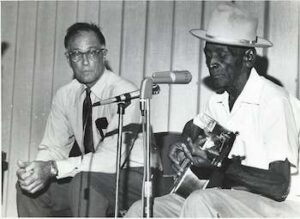
John A. Lomax Jr. (left)
*John A. Lomax Jr. was born on this date in 1907. He was a white-American folklorist, performer, and land developer.
John A. Lomax Jr. was born in Austin, Texas, United States. He was the son of John Avery Lomax and Bess Bauman Brown and the brother of Shirley Lomax, Alan Lomax, and Bess Lomax. He graduated from West High School in 1924 and earned a B.A. from the University of Texas in 1928. He began postgraduate work, but the start of the Great Depression prevented him from continuing. He also worked at a bank.
In the early 1930s, his mother, Bess Bauman Brown, died, sending his father into a depression. Lomax encouraged his folklorist father to tour the country, lecturing at universities and hunting down folk songs to add to his burgeoning collection as a manager for the folklorist family. After the folklore tour, Lomax Jr. worked as an auditor; his frequent travels across the country allowed him to find new folk songs, which he would send to his father to record for the Library of Congress.
At 34, Lomax enlisted in the Navy and met men who taught him more folk songs. After the Navy, Lomax was a land developer. He and his partner built several subdivisions in southern and northern Houston, eventually developing affordable single-family homes. Lomax's first public performance took place at Rice University on December 8, 1950, marking the beginning of numerous performances over the years. They included the University of California's Folk Music Festival at Berkeley (1960), the first two Kerrville Folk Festivals, the Cullen Auditorium at the University of Houston, and countless hootenannies.
In 1951, Lomax and others founded the Houston Folklore & Music Society. (HFMS) The HFMS preserved and celebrated folklore and folk music with public monthly meetings, membership dues, and a subscription to the Society's monthly publication, The Cottonpatch Rag. Members would sing and play guitars, banjos, and fiddles at meetings - no electric instruments or drums permitted. The HFMS's ranks included Buster Pickens, Lightnin' Hopkins, Mance Lipscomb, Townes Van Zandt, Frank Davis, Lucinda Williams, Guy Clark, and K.T. Oslin. Lomax also managed Lightnin' for about ten years, starting in the mid-1950s. The group facilitated the first meetings between many of these fledgling artists, providing them with a space to play music and share their songs.
The HFMS staged group concerts in the Jewish Community Center and the University of Houston, while solo acts frequented the club circuit. Lomax was known for his rendition of Lead Belly's "Take This Hammer" at HFMS meetings. The only accompaniment to his baritone voice was an axe and stump; he would punctuate the end of each line with a swing of the axe. Lomax introduced filmmaker Les Blank to Lightnin' Hopkins, Mance Lipscomb, and Clifton Chenier. Blank made The Blues Accordin' to Lightnin' Hopkins, A Well Spent Life (on Lipscomb), and Spend it All (on Chenier). In 1956, Lomax made the John A. Lomax Jr. Sings American Folksongs album. He also performed with Ed Badeaux, Jim McConnell, Howard Porter, and Jim Rose, a group from the Houston Folklore Society, who called themselves The Tex-i-an Boys. They were on the Songs of Texas album.
Lomax is also featured on Unexpurgated Folk Songs of Men, a raunchy folk album highlighted by Hopkins' delivery of "the dozens." The album was never commercially released due to its "dirty" song collection. Lomax also contributed "Long John" to the 1972 album Rod Kennedy Presents Kerrville Folk Festival, joining Peter Yarrow, Mance Lipscomb, Steve Fromholz, Carolyn Hester, and others. In 1967, Lomax discovered a lost manuscript that his father had written. Lomax wrote an introduction for the book Cow Trails & Cattle Camps. In 1969, Lomax recorded himself singing 160 of his favorite folk songs.
His son, John Lomax III, eventually rediscovered these tapes and selected 16 to create the album FOLK in 2017. John Lomax Jr. suffered a fatal stroke at home on December 12, 1974. His lifelong celebrations of folklore and music carry on through the still-regular meetings of the HFMS. His younger son, Joe, followed in his footsteps as a performer. His older son, John M. Lomax III, and grandson, John Nova Lomax, continue the family tradition by writing extensively about music and musicians.
To Become a musician or Singer
To become a sound and video producer